Topology Optimization of an Automotive Seatbelt Bracket Considering Fatigue
Abstract
:1. Introduction
2. Problem Formulation and Research Methodology
2.1. Assembly Geometry, Forces, and Material Properties
2.2. Finite Element Analysis and Topology Optimization
3. Results and Discussion
4. Conclusions
- The suggested methodology was effective to optimize the bracket assembly for the extreme loading and fatigue life required.
- The optimization process took 140 iterations and showed convergence stability after 80 iterations. The optimized part mass was 77% lower compared to original bracket assembly.
- The optimized geometry achieved 21% lower maximum stress compared to bracket assembly.
- Maximum stress during durability analysis was 33 MPa, and the minimum number of duty cycles was estimated to be one million cycles.
- The proposed design optimization scheme has proven computational efficiency due to its simplicity and use of standard commercially available solvers.
Author Contributions
Funding
Data Availability Statement
Conflicts of Interest
References
- Abdelhafeez, A.M.; Soo, S.L.; Aspinwall, D.K.; Dowson, A.; Arnold, D. The Influence of Burr Formation and Feed Rate on the Fatigue Life of Drilled Titanium and Aluminium Alloys Used in Aircraft Manufacture. CIRP Ann. 2018, 67, 103–108. [Google Scholar] [CrossRef]
- Holmberg, E.; Torstenfelt, B.; Klarbring, A. Fatigue Constrained Topology Optimization. Struct. Multidisc. Optim. 2014, 50, 207–219. [Google Scholar] [CrossRef]
- Oest, J.; Lund, E. Topology Optimization with Finite-Life Fatigue Constraints. Struct. Multidisc. Optim. 2017, 56, 1045–1059. [Google Scholar] [CrossRef]
- Guo, X.; Zhang, W.; Zhong, W. Doing Topology Optimization Explicitly and Geometrically—A New Moving Morphable Components Based Framework. J. Appl. Mech. 2014, 81, 081009. [Google Scholar] [CrossRef]
- Brighenti, R. Patch Repair Design Optimisation for Fracture and Fatigue Improvements of Cracked Plates. Int. J. Solids Struct. 2007, 44, 1115–1131. [Google Scholar] [CrossRef]
- Li, Y.; Zhou, G.; Chang, T.; Yang, L.; Wu, F. Topology Optimization with Aperiodic Load Fatigue Constraints Based on Bidirectional Evolutionary Structural Optimization. CMES 2021, 130, 499–511. [Google Scholar] [CrossRef]
- Boursier Niutta, C.; Tridello, A.; Paolino, D.S. Fatigue Design of Additive Manufacturing Components through Topology Optimization: Comparison of Methodologies Based on the Defect Distribution and on the Stress Gradient. Fatigue Fract. Eng. Mater. Struct. 2023, 46, 3429–3445. [Google Scholar] [CrossRef]
- Hou, J.; Zhu, J.; Wang, J.; Zhang, W. Topology Optimization of the Multi-Fasteners Jointed Structure Considering Fatigue Constraints. Int. J. Simul. Multidisci. Des. Optim. 2018, 9, A4. [Google Scholar] [CrossRef]
- Lee, Y.-S.; González, J.A.; Lee, J.H.; Kim, Y.I.; Park, K.C.; Han, S. Structural Topology Optimization of the Transition Piece for an Offshore Wind Turbine with Jacket Foundation. Renew. Energy 2016, 85, 1214–1225. [Google Scholar] [CrossRef]
- Azad, M.M.; Kim, D.; Khalid, S.; Kim, H.S. Topology Optimization and Fatigue Life Estimation of Sustainable Medical Waste Shredder Blade. Mathematics 2022, 10, 1863. [Google Scholar] [CrossRef]
- Ye, H.; Zhang, Y.; Wei, N.; Wang, W.; Xiao, Y. The Fatigue Topology Optimization of Orthotropic Materials. J. Phys. Conf. Ser. 2023, 2535, 012027. [Google Scholar] [CrossRef]
- Desmorat, B.; Desmorat, R. Topology optimization in damage governed low cycle fatigue. Comptes Rendus Mécanique 2008, 336, 448–453. [Google Scholar] [CrossRef]
- Nvss, S.; Esakki, B.; Yang, L.-J.; Udayagiri, C.; Vepa, K.S. Design and Development of Unibody Quadcopter Structure Using Optimization and Additive Manufacturing Techniques. Designs 2022, 6, 8. [Google Scholar] [CrossRef]
- Zhao, T.; Zhang, Y.; Ou, Y.; Ding, W.; Cheng, F. Fail-Safe Topology Optimization Considering Fatigue. Struct. Multidisc. Optim. 2023, 66, 132. [Google Scholar] [CrossRef]
- Jeong, S.H.; Lee, J.W.; Yoon, G.H.; Choi, D.H. Topology Optimization Considering the Fatigue Constraint of Variable Amplitude Load Based on the Equivalent Static Load Approach. Appl. Math. Model. 2018, 56, 626–647. [Google Scholar] [CrossRef]
- Kudarauskas, N. Analysis of Emergency Braking of a Vehicle. Transport 2007, 22, 154–159. [Google Scholar] [CrossRef]
- Xiao, S.; Yang, J.; Crandall, J.R. Investigation of Chest Injury Mechanism Caused by Different Seatbelt Loads in Frontal Impact. Acta Bioeng. Biomech. 2017, 19, 53–62. [Google Scholar] [CrossRef]
- Múčka, P. International Roughness Index Thresholds Based on Whole-Body Vibration in Passenger Cars. Transp. Res. Rec. 2021, 2675, 305–320. [Google Scholar] [CrossRef]
- Kumaresh, S.A.; Aladdin, M.F. A Study of Vibration Transmission on Seated Person in Passenger Vehicle. AIP Conf. Proc. 2019, 2137, 040001. [Google Scholar]
- Pan-Zagorski, W.; Johnson, P.W.; Pereny, M.; Kim, J.H. Automotive Seat Comfort and Vibration Performance Evaluation in Dynamic Settings. Appl. Sci. 2022, 12, 4033. [Google Scholar] [CrossRef]
- ISO 2631-1:1997; Mechanical Vibration and Shock—Evaluation of Human Exposure to Whole-Body Vibration. Part 1: General Requirements. International Organization for Standardization: Geneva, Switzerland, 1997. Available online: https://www.iso.org/standard/7612.html (accessed on 28 August 2024).
- Kaščak, J.; Gašpár, Š.; Paško, J.; Husár, J.; Knapčíková, L. Polylactic Acid and Its Cellulose Based Composite as a Significant Tool for the Production of Optimized Models Modified for Additive Manufacturing. Sustainability 2021, 13, 1256. [Google Scholar] [CrossRef]
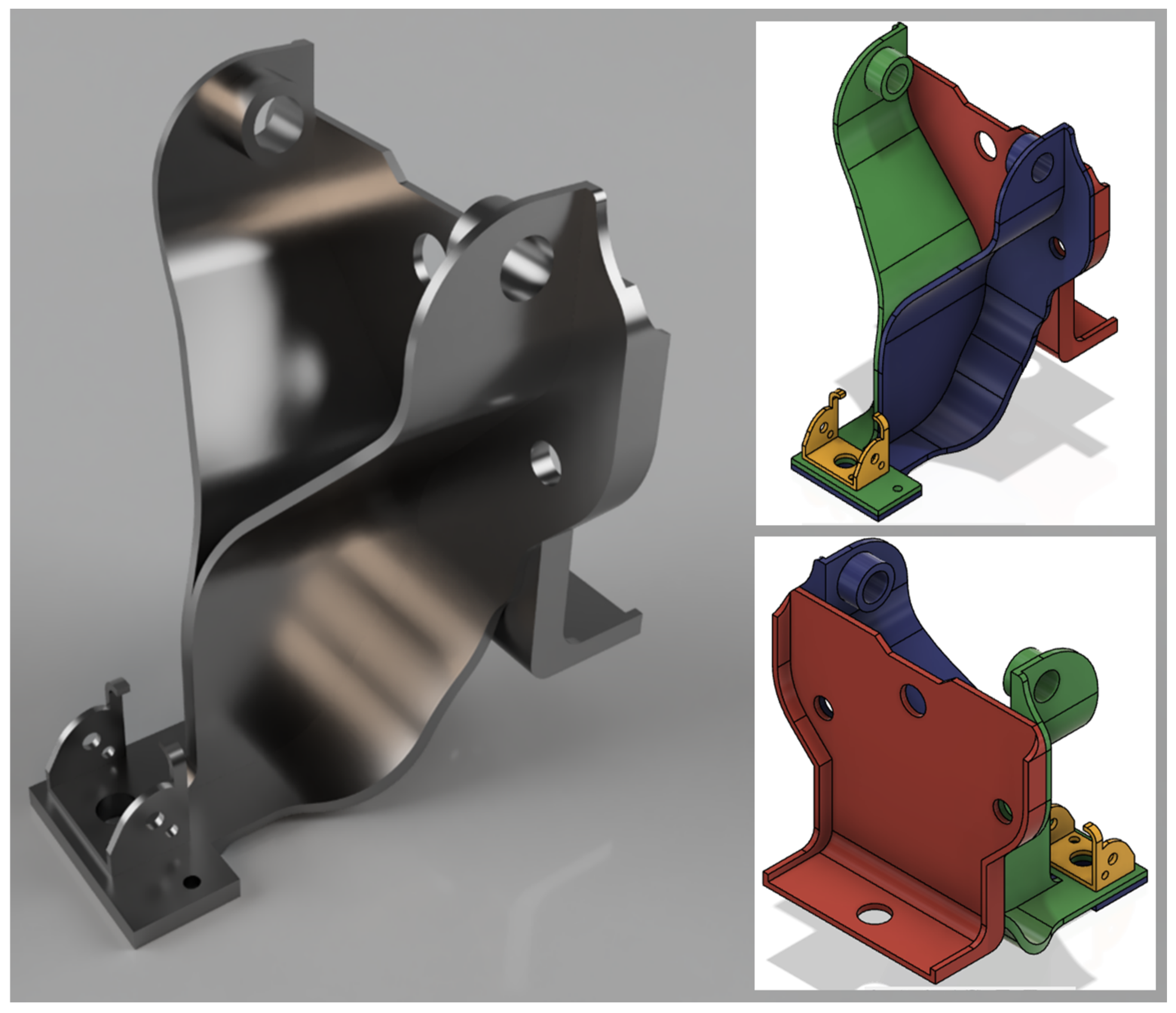
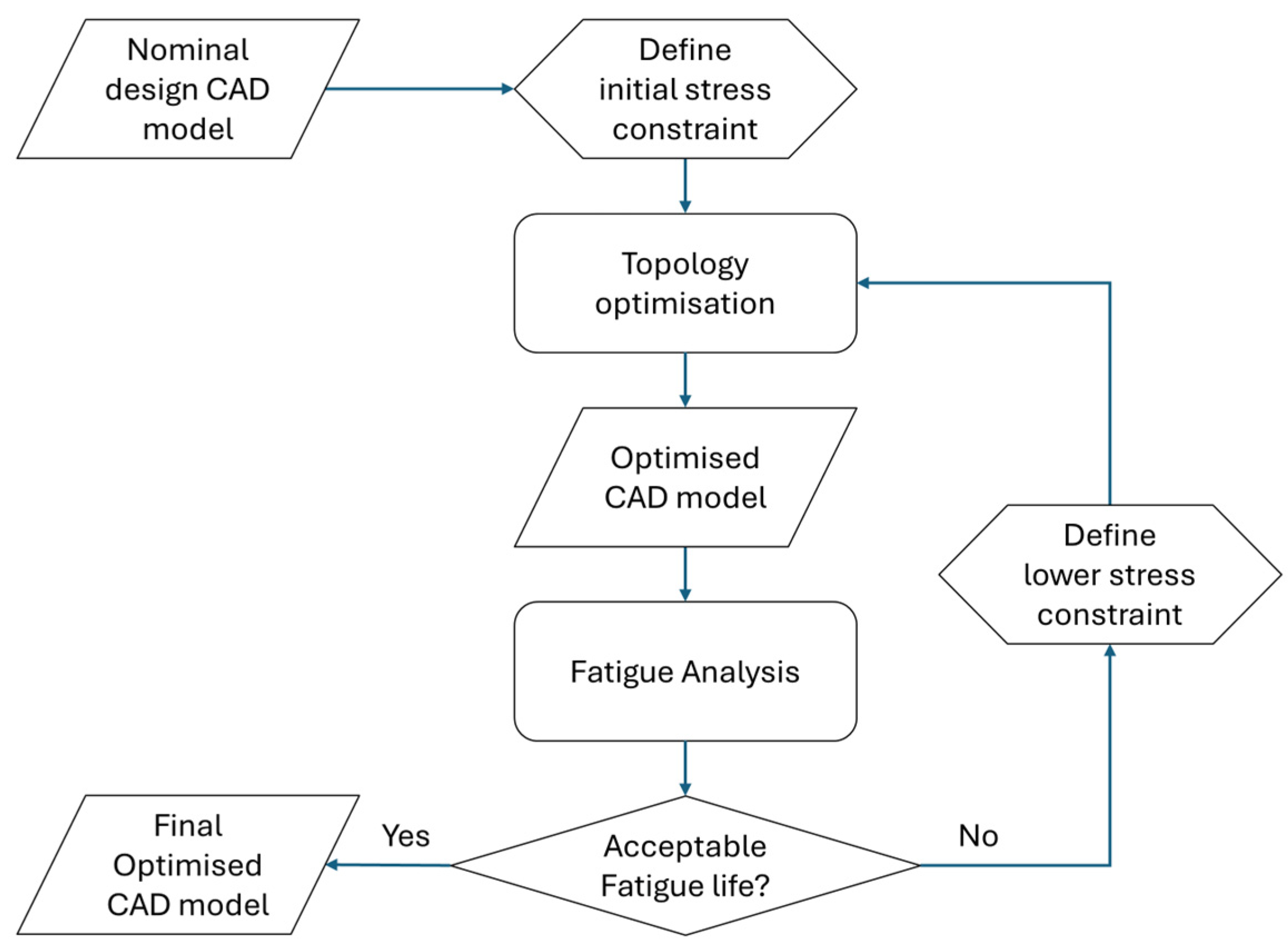
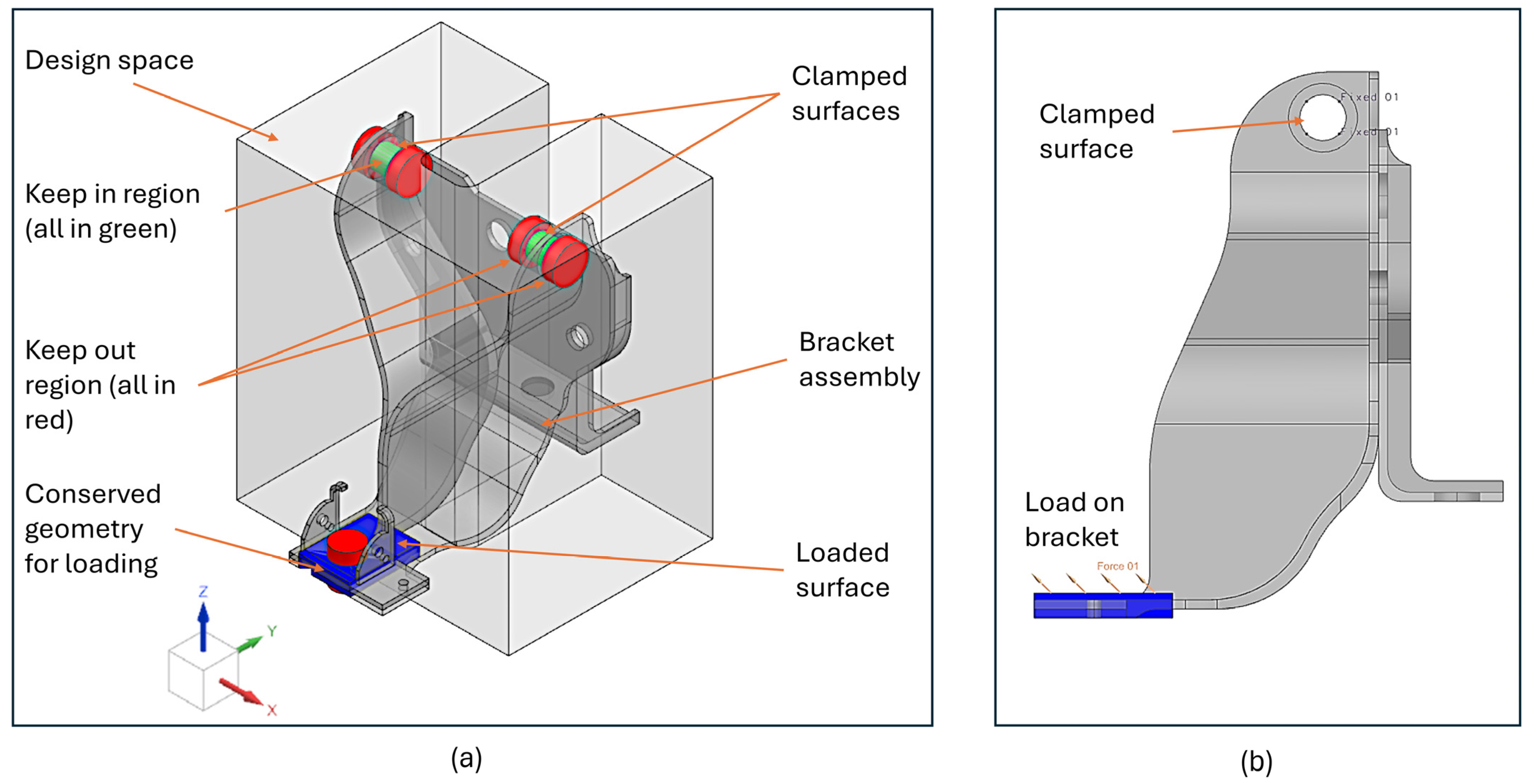

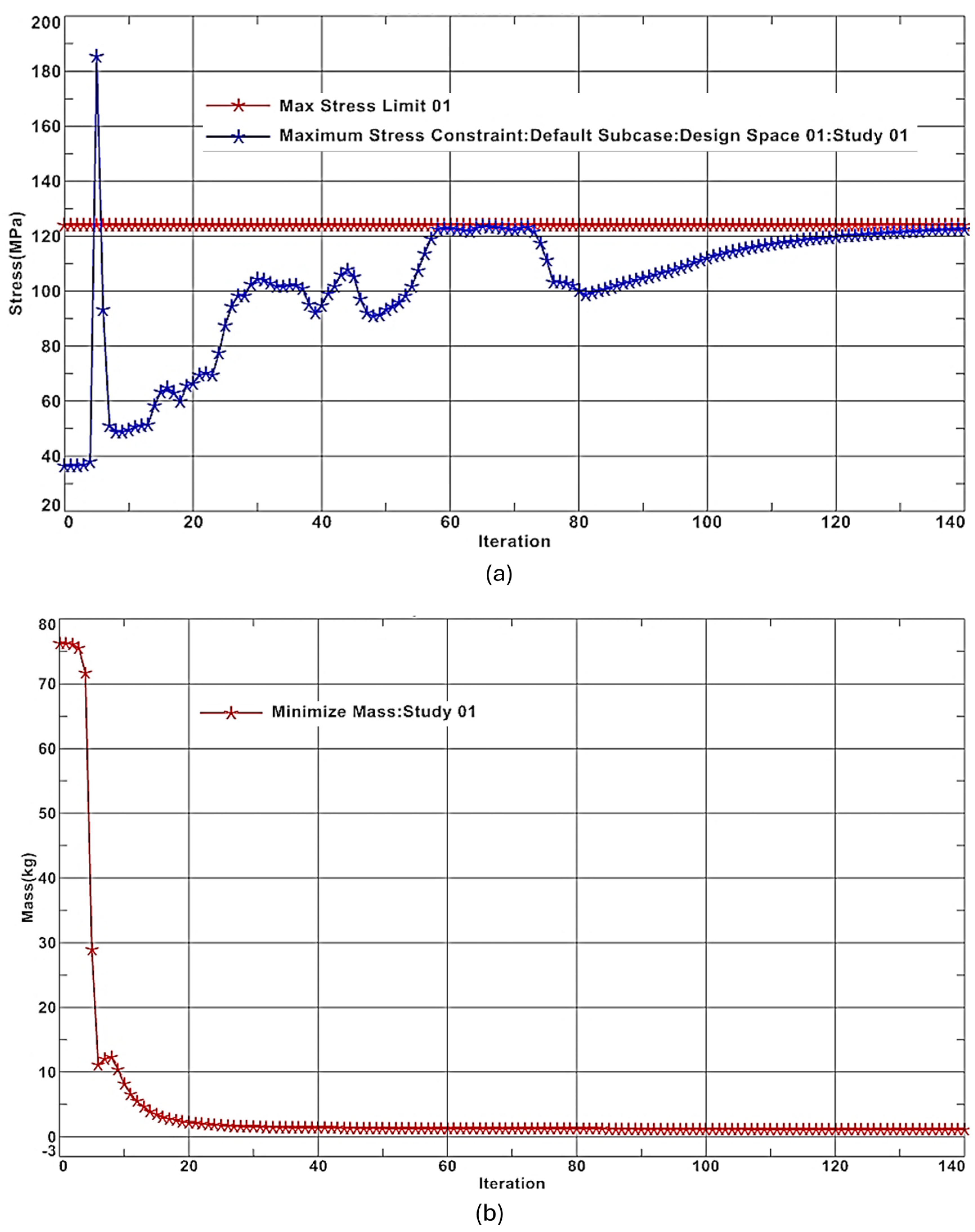
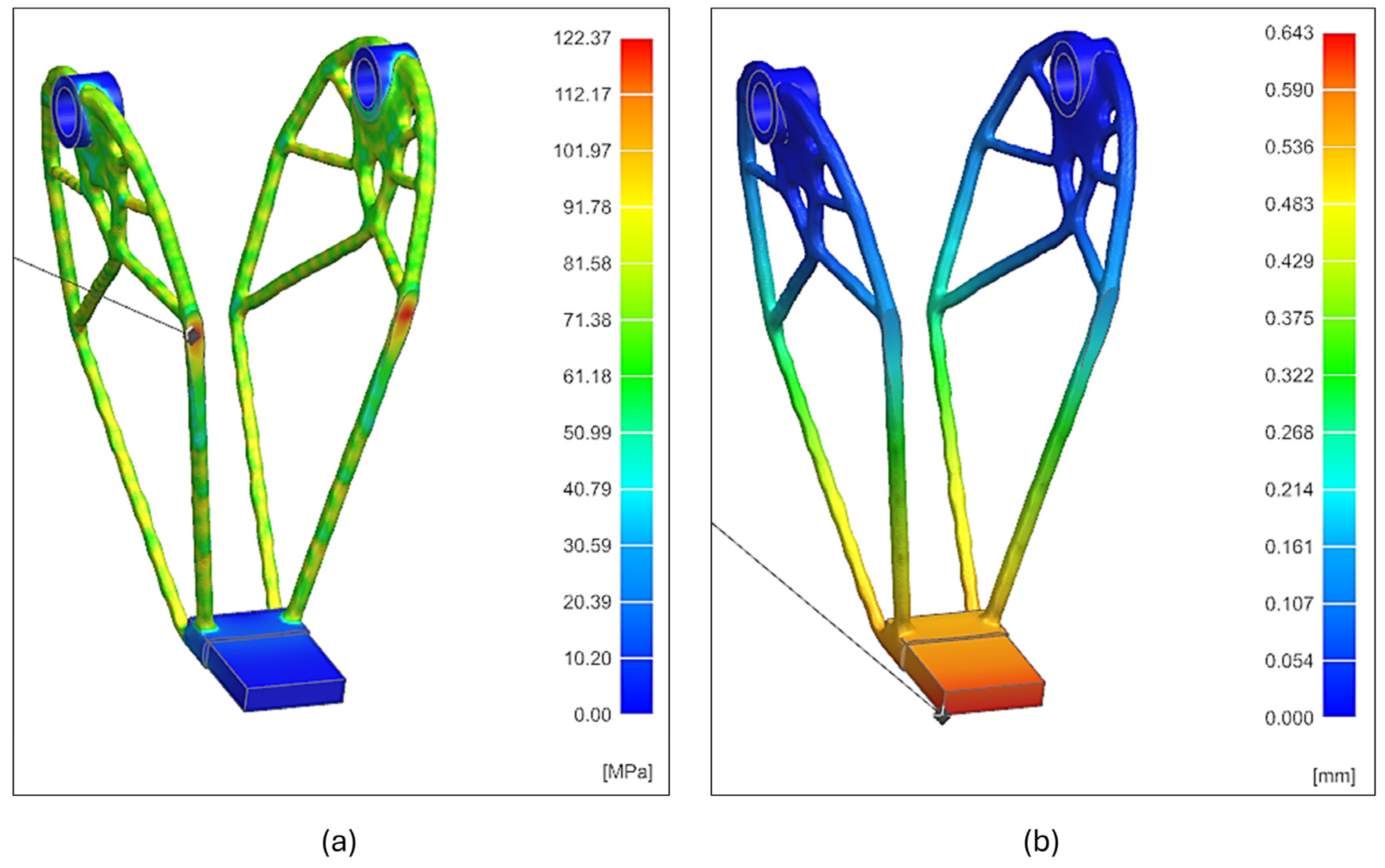

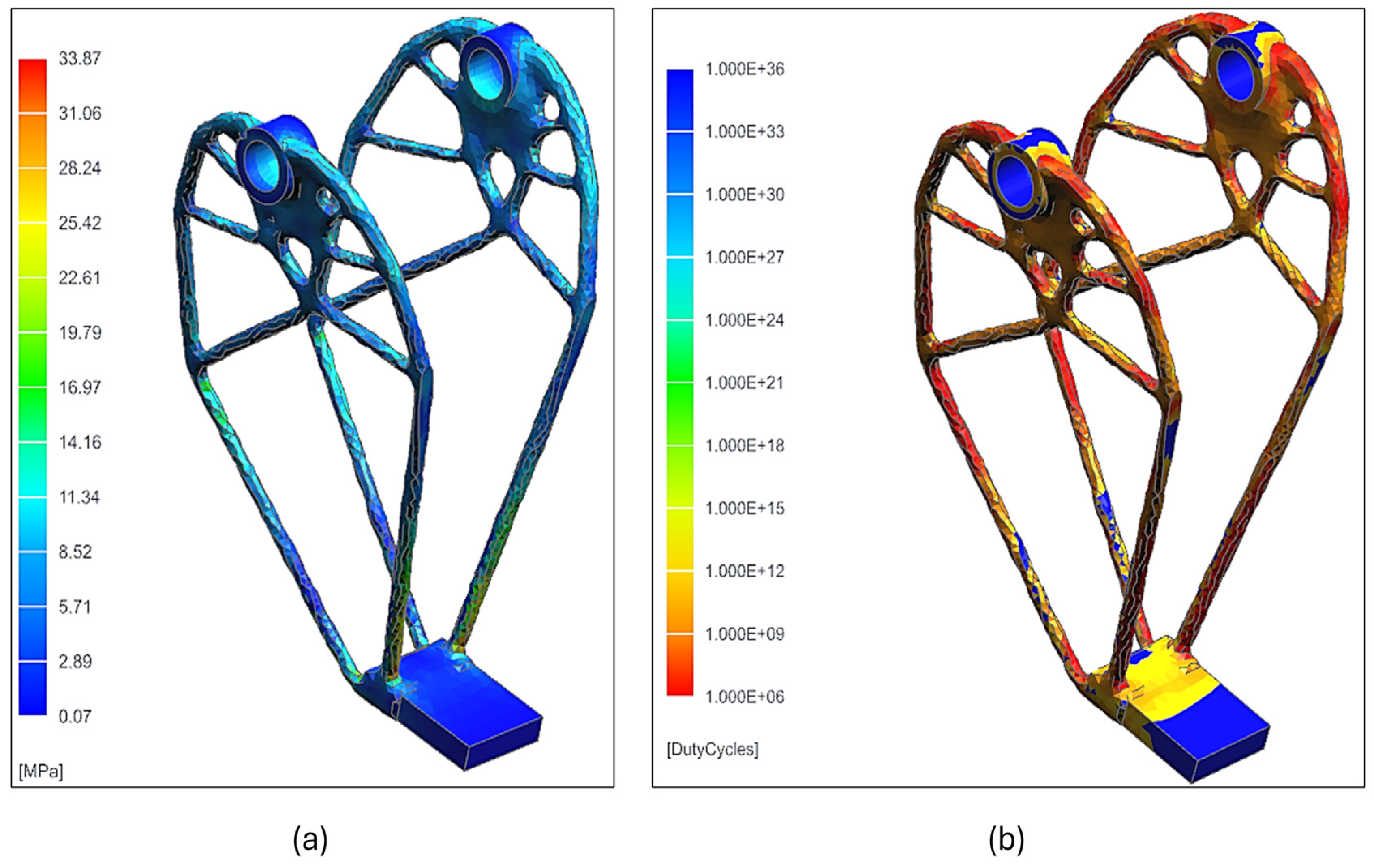
| Property | Value |
|---|---|
| Density (kg/m3) | 7870 |
| Modulus of elasticity (GPa) | 200 |
| Poisson’s ratio | 0.27 |
| Yield stress (MPa) | 200 |
| Tensile strength (MPa) | 500 |
| Endurance limit (MPa) | 260 |
Disclaimer/Publisher’s Note: The statements, opinions and data contained in all publications are solely those of the individual author(s) and contributor(s) and not of MDPI and/or the editor(s). MDPI and/or the editor(s) disclaim responsibility for any injury to people or property resulting from any ideas, methods, instructions or products referred to in the content. |
© 2024 by the authors. Licensee MDPI, Basel, Switzerland. This article is an open access article distributed under the terms and conditions of the Creative Commons Attribution (CC BY) license (https://creativecommons.org/licenses/by/4.0/).
Share and Cite
Hassan, A.A.; Biswas, B. Topology Optimization of an Automotive Seatbelt Bracket Considering Fatigue. Designs 2024, 8, 99. https://doi.org/10.3390/designs8050099
Hassan AA, Biswas B. Topology Optimization of an Automotive Seatbelt Bracket Considering Fatigue. Designs. 2024; 8(5):99. https://doi.org/10.3390/designs8050099
Chicago/Turabian StyleHassan, Ali Abdelhafeez, and Bikram Biswas. 2024. "Topology Optimization of an Automotive Seatbelt Bracket Considering Fatigue" Designs 8, no. 5: 99. https://doi.org/10.3390/designs8050099







